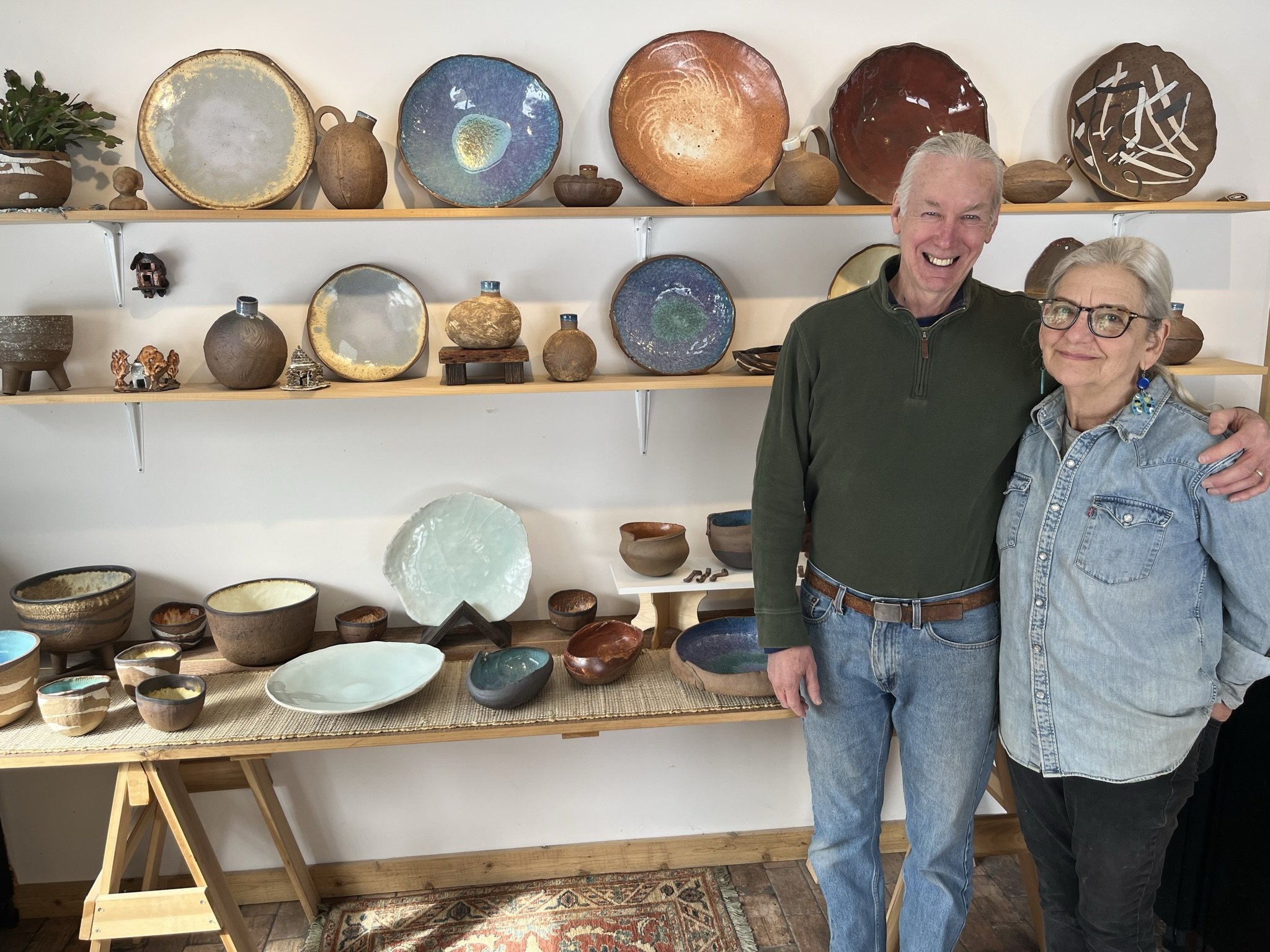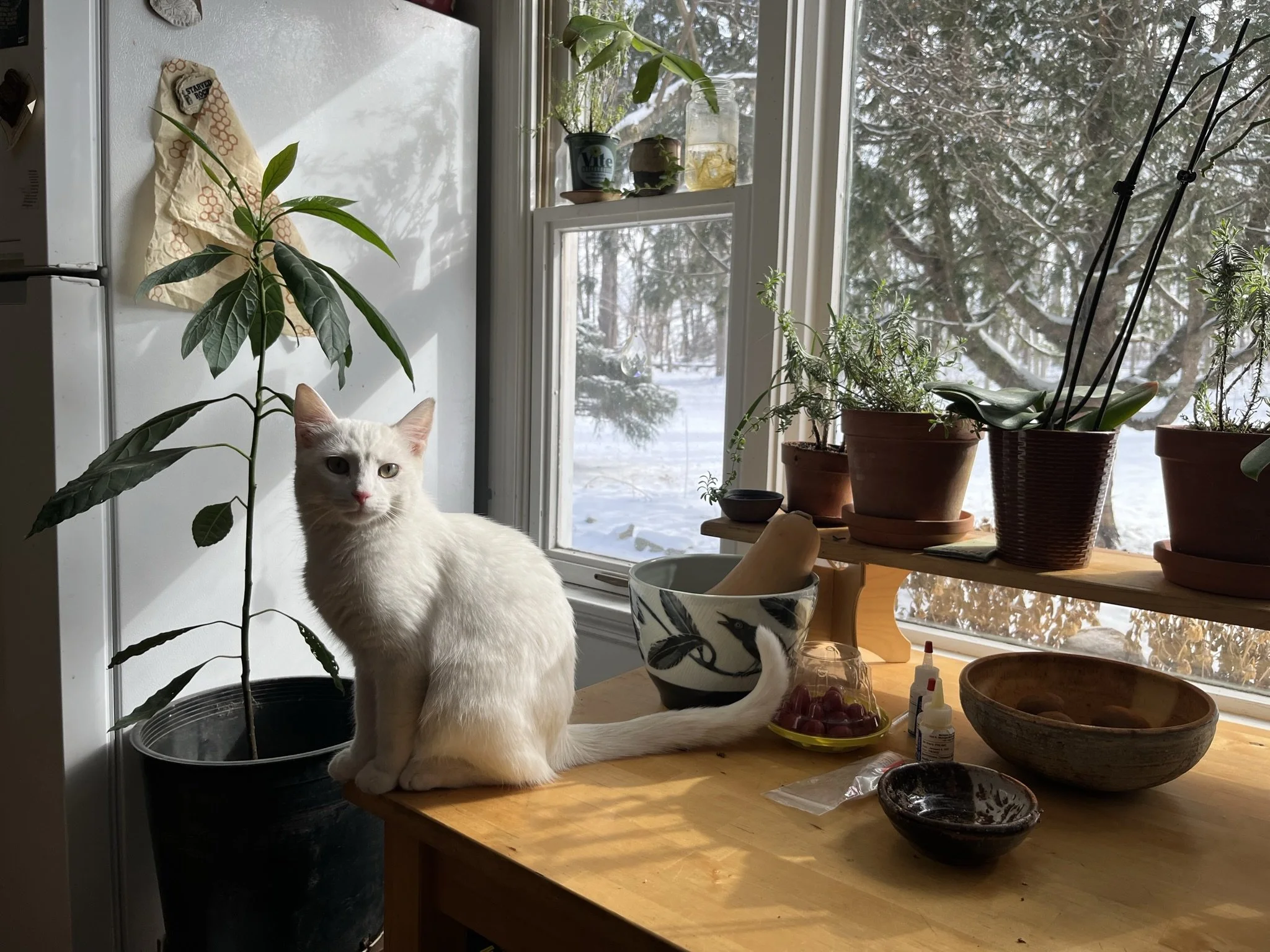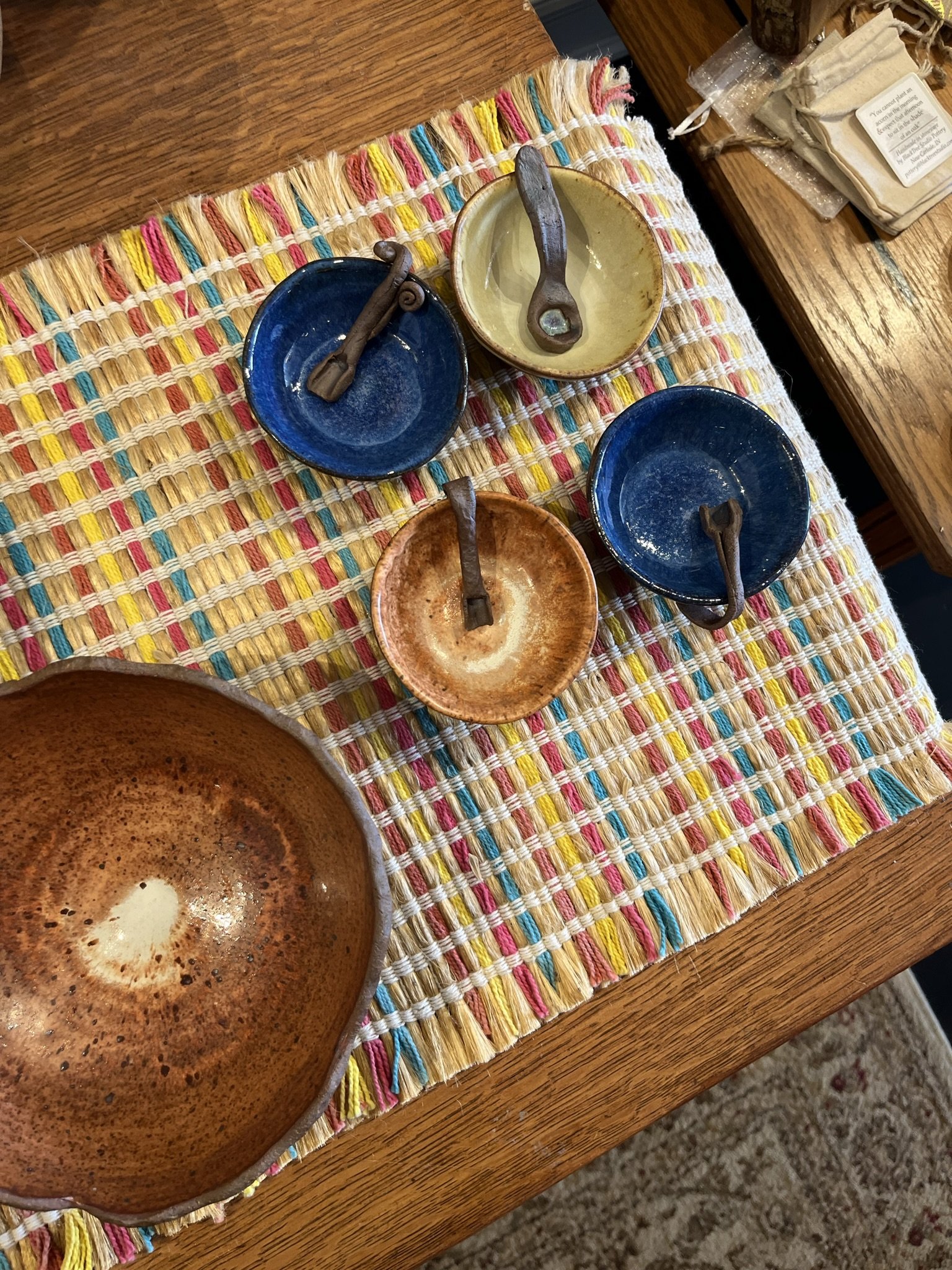Skinners Play with Clay
by Katie Jamieson
“This is a watermelon,” says Steve Skinner, the potter behind BlackTree Studio Pottery, as he holds up a round bowl glazed in what he calls “serena blue” on the inside. “See, I’ve carved on it so the detail is different.”
Steve, based in New Carlisle, Indiana, makes molds of watermelons, squash and rocks from his garden and then uses the molds to create bowls, jugs and teapots. Some of the melon bowls even show where the stem was cut says Louise Belmont-Skinner, Steve’s wife and business partner.
“This is called a favorite bowl,” says Louise, who runs the business side of things, photographing each piece, managing the online store and marketing, packing and shipping orders, and more from their charming studio in the country.
Steve and Louise Skinner at their home in New Carlisle, Indiana.
A little white cat, Sir Harry, two energetic dogs, Pepper (border collie mix) and Jack (Australian cattle dog/Labrador retriever mix), and lots of plants keep Louise and Steve company as they work in their studio and welcome customers to the gallery, which is populated by “contemporary sculpted & functional stoneware” usually glazed on the inside, but not on the outside.
“I’m very influenced by Mayan art,” says Steve. “I think of it as coming out of an archeological dig sort of thing. A lot of it happens by accident. I really like experimenting with what I’m doing, with what the clay is doing—the forms just come out of playing and experimentation and happened by accident, and if I like the accident, then I keep going with it, and it evolves and becomes refined.”
Sir Harry
A watercolor painter for most of his life, Steve transitioned to pottery after moving to New Carlisle in 2006. He and Louise had been living in Chicago for about 40 years, but they felt like it was time to leave Bucktown, as the neighborhood was getting less and less diverse, and feeling less like home.
“I was trying to figure out what my subject matter was. I was floundering. I didn’t want to paint barns. I didn’t feel like painting corn fields. I did try,” says Steve. “Then I got a lightbulb in my head while I was working outside—pottery! ‘They make pottery in the country, don’t they?’”
He enrolled in a month-long, one-day-a-week pottery workshop at Lillstreet Art Center in Chicago, where he was still commuting to teach art courses at Columbia College’s School of Art & Design. He says it felt so good getting his hands into the clay. He was “totally hooked, just like that.”
“It’s funny when I look back that I got into watercolor so heavy because I’m a very hands-on guy,” says Steve, adding that he enjoyed working on cars and motorcycles in his youth and even did woodworking as a day job for a time.
In 2008, with a newfound love for working with clay, he and Louise launched BlackTree Studio Pottery. In addition to the pieces he makes using molds from items found in their garden, he also makes cups, casseroles, platters, crucibles, ramekins, and companions—small head-and-shoulder sculptures made from a mold of a baby doll.
Steve is a natural teacher. After moving to Michiana, he taught for two years at Indiana University South Bend. Before that, he taught at Columbia College, the Chicago Department of Cultural Affairs, and the School of the Art Institute of Chicago.
For the past 8 years or so, he’s put all that teaching energy into training his interns.
“They’re learning everything about pottery that I know,” says Steve. “There are some new things in there, platters that just happened the other day—I’m really happy with that. The intern, who is really good, is giving me more space to make what I want because she’s learning to make stuff we need to fill orders.”
Louise adds, “For the first time, we’re actually paying them! It’s miniscule, piecemeal.”
But it’s something. Plus, interns get access to the studio, the clay, the kilns and Steve’s more than 40 years of experience as a working artist—15 years as a potter and 25 as a watercolorist.
Steve says that one of the biggest things he brings into pottery from his painting days is his understanding of color. He even used to teach color theory.
“I’m very aware of color. I know color,” says Steve, who explains that working with glazes was pretty challenging at first. “When you mix up a glaze, it looks like mud. It might have a slight tinge to it, but most don’t have any color at all. When I first started, that was kind of difficult for me, because when you paint, you see the pigment and color come right out of the tube. With this you had to visualize and know what the color was going to be or think of what it was going to be at the end of the fire.”
Not only that, but many variables affect the final glaze color once a piece goes inside the kiln.
“The same color at the top may be dramatically different at the bottom of the kiln,” says Steve. “I’m aware of that and do that sometimes, kind of painting with the kiln—using heat, very intense heat to change colors of where it’s going to be at in the kiln.”
It can get up to 2400 degrees Fahrenheit inside his two kilns during a firing, which takes about 16 hours each time. Steve helped build both kilns, naming one after his mother, the Joyce Kiln, and one after his grandmother and grandfather, the Elene William Kiln. It takes about four days for the fired pieces to cool all the way down, which is a long time to wait to see how they turned out.
Steve says he doesn’t mind if something turns out different than expected, but still “looks cool.” For instance, his method of glazing only one side of the clay required some early trial and error to prevent pieces from breaking under the pressure that can build while firing a partially-glazed piece. He also mixes porcelain with stone, though they shrink at different rates in the heat.
“If you don’t do it right, it pops out. You have to know what you’re doing. I don’t know anybody else off hand doing this because you are taught specifically in pottery not to do it, unless you’re marbling it, when it’s really thin, not inlay,” says Steve. “If I was taught something and told I couldn’t do it, I would say to myself—and I’ve done this all throughout my art career—‘I bet there’s a way.’”
Louise adds, “We often say we never learned what we shouldn’t do because we weren’t academically trained in pottery, per se.”
She and Steve attended the School of the Art Institute of Chicago at different times, she for photography and he for printmaking and watercolor painting. At the start of her career, Louise was an exhibit designer for the Chicago Field Museum. Later she became the director and then vice president of exhibits at the Chicago Children’s Museum. She still does photography and dabbles in pottery, too.
“I amuse myself in the studio by making what I call little spice bowls and little spoons, and my muscle men,” she says. “My muscle men are great! They’re all, like, kitschy, or they all have a story. Even when I do a description of a piece of pottery, even when I take a photo of it, in my brain, I’m like, ‘Oh look, those two pieces of pottery, they just fell in love, and now they’re hugging.’”
Louise also makes little clay acorns and house sculptures. The “Safe House” series started out as a reaction to Trump’s presidency, and now she’s taking on some custom orders.
“I was scared of trump. I wanted a safe place to hide, someplace I could go,” says Louise as she picks up one of the houses and turns it upside down. “This one says, ‘safe forever.’”
Louise’s work can be found alongside Steve’s at their gallery, which is connected to their studio, and at The Potter’s Wife inside Feeney’s Hometown Goods in downtown New Carlisle. Steve’s work is also for sale online since the COVID-19 pandemic spurred them to shift their business strategy.
Before COVID, they’d been attending many shows and producing a lot of pieces for the wholesale market. Since cutting travel and event fees, and shifting to selling online and offering more gallery hours, they’ve found that their bottom line has actually improved, while also allowing Steve more creative freedom.
“I was just busting my butt putting out some of these orders, not just for the shows, and for wholesale, but I was actually hurting my body,” says Steve, gesturing at his right shoulder. “We’re not making as much stuff—we don’t have to. That gives me more time to experiment and play with the forms and play with the clay, so different things come out. I have more time for that.”
BlackTree Studio Pottery
Gallery hours:
Friday and Saturday, 10am–5pm
Sundays, noon–5pm
By appointment: 773.318.9161, pottery@blacktreestudio.com
Photos by Katie Jamieson
Published first April 2022








